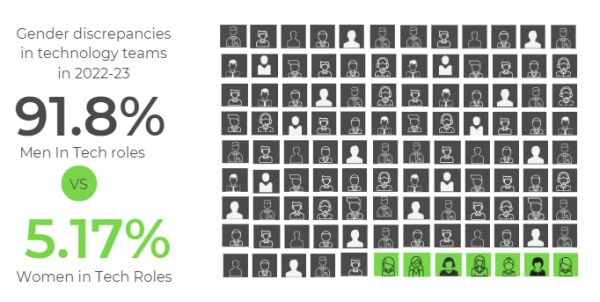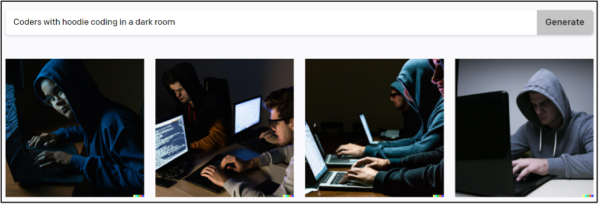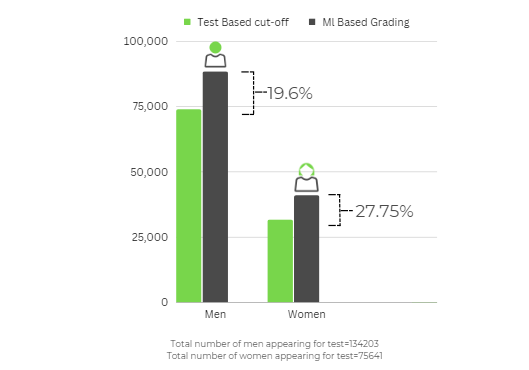Using AI to Address Gender Diversity in Technology Teams
SHL Labs’ latest study shows that an equitable assessment process for tech teams can help companies improve gender disparity, hence promoting DEI efforts.
Share
'Diversity: the art of thinking independently together'
Malcolm Forbes
It is a proven and accepted fact that having a diverse and inclusive team leads to better productivity and shows higher creativity in the workplace. A recent study by Harvard Business Review discusses the impact of having more women in the tech workforce, which is estimated to raise the global GDP by 3% to 6%—a 2.5 - 5 trillion USD boost to the global economy, yet even today women continue to be underrepresented in technology teams.
“Diversity in tech” is an initiative that most companies claim to prioritize, but is it virtue signaling or will it be a measure of success? In their recent survey of over 52k professional developers, Stack Overflow found that men dominate the tech industry with 91.88% of respondents identifying as male and 5.17% identifying as female. This trend is seen in another report from TrustRadius in 2021 which surveyed 297 women in the tech industry to understand their experiences. The key themes that came through were that the industry suffers from a prominent "Bro Culture" with 72% of women saying that they had experienced it personally. They often feel outnumbered in meetings where it is common for the ratio of males to females to be higher than 2:1 and women are 4x more likely to see gender bias as an obstacle to progressing in their careers.

To investigate this further, we asked the world-famous AI artist DALL-E developed by Open AI to generate examples of “Coders with Hoodie coding in a dark room” and they gave us the following images.

If you look closely at the generated images, the person behind the hood hacking and coding is always a “Man”. Why blame the model, when we are living in a world where gender disparities are still commonly observed in tech teams?
How does SHL fix this problem?
Assessments are a primary gateway to getting into technology teams. A typical hiring process for a software engineer/ developer involves candidates solving a coding problem (2-3 in most cases) in a fixed time, which is followed by multiple rounds of personal interviews. These coding problems are generally evaluated using test cases, the more you pass the better your chances of going through are.
We all know that coding is tricky. Just a miss of a comma or that inverted operation can make you scratch your head and pull your hair till you drop. What if you lose out on a brilliant developer, with a great understanding of logic because of that ‘not-so-innocent' mistake?
Using such rigid and a binary approach to solving test cases to grade candidates’ abilities is unfair. Such stringent and conventional assessments have led to serious damage to the already unfavorable male-to-female ratios in tech teams. These assessments are stocking similar gentry with the similar skillset, ignoring the other important aspects of a “top developer” such as the ability to think through the problem to write functional code while adhering to the principles of writing clean. Additionally, the efficiency of the candidate's logic and algorithm, in terms of time and space complexity, is also a critical factor to consider.
Any proficient tech interviewer would know that while selecting a candidate for a software developer role, it is important to assess more than just the candidate's ability to write code that passes test cases.
Thus, we present Automata which uses machine learning-based techniques to grade computer programs. This is proven to grade a candidate based on a holistic approach rather than just the functional feasibility of the code. With this, we can even grade programs that did not even compile. We found that the machines’ (Automata’s) agreement in selecting the right candidate for a tech role with human experts was as high as 0.8-0.9 correlation points (The correlation value ranges between +1 (perfect direct relationship) and −1 (perfect inverse relationship)).
But wait, how does this solve gender disparity?

Keeping the above-mentioned considerations to find an ace software developer in mind, SHL Labs conducted an analysis of 200k applicants for the role of a software engineer in the last 1 year. We found that 25% more developers or candidates would qualify for the next round when we used a machine learning-based algorithm to evaluate programs instead of a typical test-cases-based scoring mechanism. Even more surprising was the fact that using this test-cases-based approach, you end up impacting more self-identified females than males! There was a striking 27.75% jump in the number of females qualifying (Clearing the cut-off score) for the role after we adopted our ML-based grading.
Gender diversity in technology teams has always been a challenge. By incorporating such AI-assisted solutions and practices into the hiring process, companies can improve the diversity and quality of candidates being hired for technology roles. This approach has been shown to increase the number of women and other underrepresented groups in tech teams, as well as improve the overall quality of talent being hired. The adoption of AI and ML-based technologies in the hiring pipeline leads to a higher inclusion rate.
We are not done innovating yet and we continue to build products that help you in your DEI efforts, providing value to your employees and candidates.
Check out our projects at SHL Labs, where our team of experts joins hands to advance innovation in talent acquisition and management.











